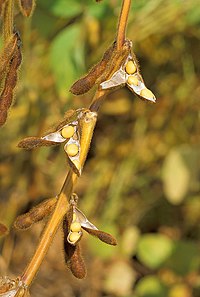
QTL mapping and candidate gene identification of lint percentage based on a recombinant inbred line population of upland cotton
Sign Up to like & getrecommendations! Published in 2021 at "Euphytica"
DOI: 10.1007/s10681-021-02823-x
Abstract: Lint percentage is a major yield component in cotton breeding programmes. To identify quantitative trait loci (QTLs) and candidate genes related to lint percentage, we used an intraspecific recombinant inbred line population of 137 lines… read more here.
Keywords: percentage; cotton; inbred line; recombinant inbred ... See more keywords

Marker assisted breeding for introgression of opaque-2 allele into elite maize inbred line BML-6
Sign Up to like & getrecommendations! Published in 2017 at "Acta Ecologica Sinica"
DOI: 10.1016/j.chnaes.2017.04.002
Abstract: Abstract Improvement of QPM (Quality Protein Maize) along with high content of lysine and tryptophan had foremost importance in maize breeding programme. The efficient and easiest way of developing QPM hybrids was of backcross breeding… read more here.
Keywords: bml; inbred line; line; selection ... See more keywords

CO475 corn inbred line
Sign Up to like & getrecommendations! Published in 2020 at "Canadian Journal of Plant Science"
DOI: 10.1139/cjps-2020-0057
Abstract: Abstract: CO475 is an early-medium maturity (75 d to flowering), mostly Iodent, yellow semi-dent inbred that combines well with several testers in many different locations. It has moderate resistance to gibberella ear rot (both the… read more here.
Keywords: corn inbred; co475 corn; inbred line;

Effects of Inbreeding on Genetic Characteristic, Growth, Survival Rates, and Immune Responses of a New Inbred Line of Exopalaemon carinicauda
Sign Up to like & getrecommendations! Published in 2020 at "International Journal of Genomics"
DOI: 10.1155/2020/5735968
Abstract: The Exopalaemon carinicauda could be a useful crustacean laboratory animal in many research fields. We newly established an inbred line of Exopalaemon carinicauda named EC4 inbred line by brother×sister mating and keeping to F11 generation.… read more here.
Keywords: ec4 inbred; line; inbred line; exopalaemon carinicauda ... See more keywords

Quantitative trait loci mapping of Meloidogyne incognita and M. hapla resistance in a recombinant inbred line population of soybean
Sign Up to like & getrecommendations! Published in 2018 at "Nematology"
DOI: 10.1163/15685411-00003157
Abstract: A recombinant inbred line population of soybean ( Glycine max ) was utilised to identify the quantitative trait loci (QTLs) determining the response to infection by two root-knot nematode species, Meloidogyne incognita and M. hapla… read more here.
Keywords: soybean; line population; inbred line; recombinant inbred ... See more keywords

Identification of Quantitative Trait Loci Associated With Iron Deficiency Tolerance in Maize
Sign Up to like & getrecommendations! Published in 2022 at "Frontiers in Plant Science"
DOI: 10.3389/fpls.2022.805247
Abstract: Iron (Fe) is a limiting factor in crop growth and nutritional quality because of its low solubility. However, the current understanding of how major crops respond to Fe deficiency and the genetic basis remains limited.… read more here.
Keywords: deficiency tolerance; inbred line; deficiency; quantitative trait ... See more keywords

Identification of Zinc Efficiency-Associated Loci (ZEALs) and Candidate Genes for Zn Deficiency Tolerance of Two Recombination Inbred Line Populations in Maize
Sign Up to like & getrecommendations! Published in 2022 at "International Journal of Molecular Sciences"
DOI: 10.3390/ijms23094852
Abstract: Zinc (Zn) deficiency is one of the most common micronutrient disorders in cereal plants, greatly impairing crop productivity and nutritional quality. Identifying the genes associated with Zn deficiency tolerance is the basis for understanding the… read more here.
Keywords: candidate genes; deficiency tolerance; recombination inbred; inbred line ... See more keywords